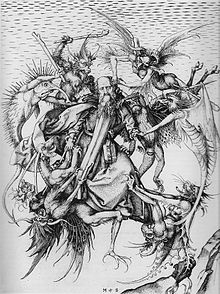Demon
![]()
The title of this article is ambiguous. For other meanings, see Demon (disambiguation).
As demon (plural demons, from ancient Greek δαίμων daímōn) is understood in various mythologies, religions and mystical teachings initially a "spirit" or a fateful power (δαιμόνιον daimónion) as a "warning or admonishing voice (of conscience)" and "doom". Under Christian influence the meaning then changed to a henchman of the "devil", and thus today, contrary to the neutral to rather positive sense of the original word for the spiritual phenomena or spiritual beings meant, a demon is often used to denote such a being which, according to common conception, frightens, threatens or harms people, i.e. appears as an evil spirit being. In the Christian tradition, the systematic study of demons is called demonology.
Demons are usually distinguished from spirits in the religious scientific sense by their relation to the body: While the spirit is independent of the body, the demon, proceeding from its sphere, enters into relation with man and exerts an influence on him. In this sense, angels and devils are also assigned to the demons, but specified by their relationship to the deity and thus distinguished from the conventional demons.
In archaeological usage, demon means an animal-headed hybrid creature (chimera) with at least human-shaped legs. The contrast to this is formed by "monsters", as mixed creatures with animal bodies and animal heads of a fantastic kind are called (e.g. griffins or dragons) or animal bodies with human heads such as sphinx (female head and lioness body), manticore (male head with lion body and scorpion tail) and centaurs (human upper body and horse body).

The Temptation of St. Anthony (15th century depiction by Martin Schongauer)
Etymology
The word derives from the Greek word δαίμων daímōn. The name daimon in Greek mythology originally stood for the spirit of the departed or, conversely, the departed spirit of the departed (Greek σκιά skiá "shadow"), the disembodied figures of the departed. In this respect a positive meaning seems to have been prominent as long as the legend was of any importance, in which the souls of the people of the golden age were called δαίμονες daimones, representing thereby "an intermediate stage between gods and men, a second class of lower gods." In a very similar sense there exists in German the word Schemen (compare also "schemenhaft"), which is only rarely used, for ghosts, spirits, and spooky figures. These and other word formations (such as scheinen, schimmern, schier and Schimmel) are based on the Indo-European root word *skai- in the meaning of "(dull) glisten, shine, reflection", according to the dictionary of origins of the Großer Duden.
The dictionary of origin of the Großer Duden gives the meaning of demon as "evil spirit, a middle being between God and man" and traces it back to Greek δαίεσθαι daíesthai "(to) divide, to divide, to allocate" as well as "to be divided". From there, the basic meaning of daíesthai is derived there as "to divide and apportion (fate)". Interesting are the further relations of δαίμων daímōn - on the one hand, to the Greek word for people δῆμος dēmos - as in democracy -, on the other hand, and going even further, to "time" (likewise English time; tide[(n)hub]/tides, English tide; see also line, goal, newspaper) in the sense of "section, divided off." In all of this it is linguistic-historically or etymologically a matter of derivations from the Indo-Germanic root word *da[i]- for "to divide, to tear, to cut", on which also German "Teufel" and Latin diabolus are based.
The word δαίμων daímōn, in turn, is connected with the Greek word δαιμόνιον daimónion in the meaning of fate or conscience, which invisibly accompanies man at all times. There is an estimate that it was only in the course of the Middle Ages that the term demon became associated with unpleasant ideas and thus received a shift to the negative. Pandemonium refers to the totality of all demons or their abode, which in a figurative sense is a place of horror.
Classification
Gerardus van der Leeuws (1959) is regarded as a pioneer in the study of demonology in religious studies. The demonic is divided into different genres in the sense of religious studies:
- Haunted Demons
- Nature demons (e.g. desert demons, air demons, water demons, wasteland demons, etc.)
- Demons of sickness and madness (possession, inspiration, etc.)
- Dream Demons
- Ghosts of the Dead
- Protective demons (of places, estates and professions)
Questions and Answers
Q: What is a demon according to many world religions?
A: A demon or daemon is a supernatural bad, powerful or malevolent being in many world religions.
Q: How do people perceive demons all over the world?
A: The word 'demon' has different meanings all over the world, but often there is the idea that they are spirits that lived in a place, or went with a person.
Q: What is the other meaning of the word 'demon'?
A: The word is also used for a type of computer program that does useful things in the background of a computer, but this use is not related to the religious meaning.
Q: What is the level of power that demons possess?
A: According to the definition, demons are powerful beings with the potential to cause harm.
Q: What is the religious significance of demons?
A: In many world religions, demons are viewed as supernatural entities that represent evil, temptation, and chaos.
Q: Can demons be benevolent in some religions?
A: Yes, in some religions demons can be seen as benevolent or helpful beings that assist in tasks or offer guidance.
Q: How does the concept of demons differ from religion to religion?
A: The concept of demons varies greatly from one religion to another, with different beliefs about their origin, nature, and function.
Search within the encyclopedia